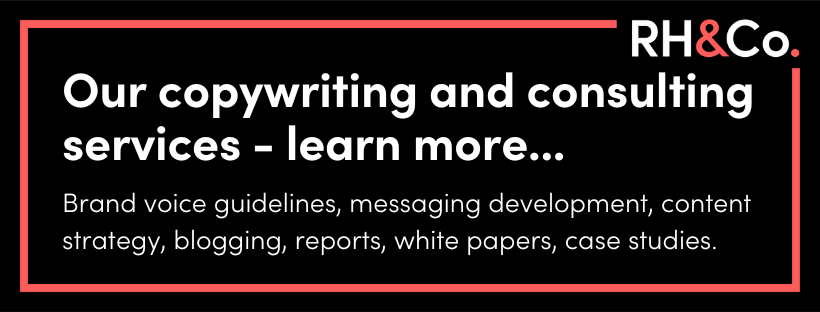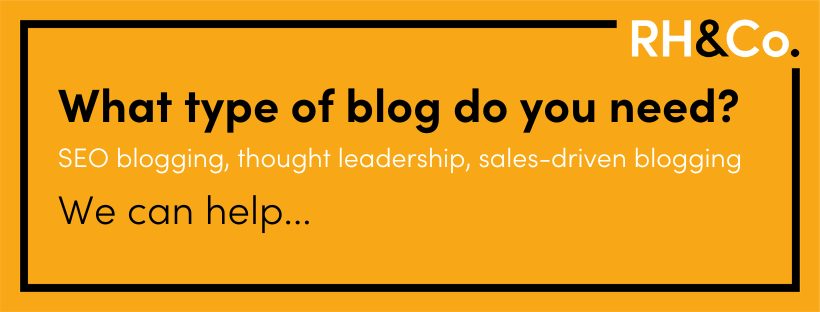Did you know that Liz is our resident linguistics expert? In the new #linguisticsliz series she’ll be demystifying some common grammar and punctuation rules that people (including copywriters!) often get wrong in their marketing copy. Today it’s all about the humble comma.
At my daughter’s assembly recently, the class dressed up as pop stars and sang a song called “AAAWWUBBIS”:
“Two clauses in one sentence yeah
You combine never asking why
A comma here
A comma there
It’s a mess no-one can deny”
Tears rolled down my cheeks at the sheer hilarious genius of it. The song is designed to help them remember when to use a comma in a complex sentence. The parent next to me whispered, “I thought you just chucked a comma in whenever you needed to pause for breath?” “No, no, no, there are RULES”, I replied in despair through my tears.
Get rid of that comma!
I am often called on to proofread copy for a website or blog before it is sent to clients. My mother was a professional proofreader and I have BSc in Language Technology so I feel at home finding typos and grammatical errors. My most frequent complaint to our writers [Rin’s note: Including me!] is the number of erroneous commas that appear before conjunctions which I must unceremoniously delete.
It is a common misconception that a comma can be thrown in whenever the reader might need to breathe. But actually there are specific points in English syntax where they are required and they cannot be thrown in on a whim.
Introducing clauses
Back to “AAAWWUBBIS”… AAAWWUBBIS is an acronym for the most common subordinating conjunctions in the English language…
“Stop, stop! What on earth is a subordinating conjunction and why do I need to know?”
You use them all the time to join up two clauses in a sentence.
“Wait. What? What’s a clause?”
OK, let’s rewind a few pages of the textbook: a clause is a mini sentence containing a verb.
For example:
I have written a blog post.
I will set off to pick my children up from school.
If I want to join these two ideas together and make one of them dependent (or subordinate) to the other I need a subordinating conjunction:
- After
- Although
- As
- When
- While
- Until
- Because
- Before
- If
- Since
See what those initials spell?
Complex sentences
Using a subordinating conjunction I can then write a complex sentence containing two clauses instead of one. There are two ways I could do this:
I will set off to pick up my children from school after I have written this blog post.
After I have written this blog post, I will set off to pick my children from school.
If I choose to use a subordinating conjunction at the start of the sentence then I need a comma between the clauses. If I use the subordinating conjunction in the middle of the sentence then I must not use a comma.
That is the rule – nothing to do with breathing or pausing!
P.S. There are lots of other sentence types that require a comma. For example, when using an adverbial phrase. I will save that for next time!
Every business needs written content. Website copy, blog posts, white papers, case studies – the list goes on. In a startup or micro business, this copy is often written by a founder or another member of the team. But eventually the need for either quality or quantity – or both – means it’s time to hire in a freelance copywriter or copywriting agency.
The question is, which one is right for your business?
In this article, we’re going to look at the advantages and disadvantages of freelance copywriters and copywriting agencies. This won’t help you select an individual writer or agency – you can read more about that in this post on how to hire a copywriter. Instead, we’ll go through some of the factors you should be considering in order to decide what will suit you best.
TL:DR
- Why use a freelance copywriter?
- Why use a copywriting agency?
- Is RH&Co right for your business?
- Conclusion
Why use a freelance copywriter?
A good freelance copywriter is worth their weight in gold. As well as our in-house writers and editors, we have a small but brilliant team of freelancers who are an integral part of the agency.
So we’re not here to suggest that copywriting agencies are in any way better than freelancers. In fact, there are many situations in which we would advise that you go down the freelance route.
Here are some factors that make freelancers appealing.
Cost
In most cases, a freelancer is likely to be less expensive than an agency simply because they don’t have the same overheads. They’re also unlikely to be earning over the VAT threshold, saving you a chunk of money if you yourself aren’t VAT registered.
Freelance rates vary widely depending on experience and even location (London prices tend to be higher than Bristol prices, for example). A junior might start out charging as little as £150 a day, whereas someone more specialist or experienced might charge four or more times that.
There is likely to be some crossover between the highest freelance rates and the rates charged by the smaller agencies though, so don’t be afraid to get a range of quotes. Just make sure you’re comparing like-for-like in terms of what’s being delivered.

Flexibility
Where agencies will have their processes in place, a freelancer may well have more flexibility. For example, they might be happy to come and work in-house at your offices for a period of time. They are also unlikely to have minimum fee or retainer terms.
Retainer relationships do make sense on a number of levels. First, there is a degree of work to be done upfront in getting to know a client and understanding their industry, establishing tone of voice, messaging and more. Also, in the case of content marketing, it takes time to see results.
But you might not want a long-term relationship. Perhaps you only need someone to do a small, one-off piece of work, or perhaps your budget is too uncertain to commit to a monthly outgoing. Or you might just be testing the water. In which case, a freelancer may be a good bet.
Control
When you work with a freelance copywriter, they essentially become an extension of your team. You’ll manage them directly rather than going through an account manager, which may give you a greater sense of having eyes on all stages of the content creation process.
This is great for founders who are naturally close to their business and feel protective of anything that gets written on their behalf, or marketing managers who are used to managing a team, setting strategy, giving feedback and generally running projects.
If your business is growing and your copy requirements are likely to grow with it, then you need to be sure that your provision will be able to expand to meet that.
Why use a copywriting agency?
This is not where we do a big old sales pitch. As we’ve demonstrated above, there are many reasons why you might need a freelance copywriter. And if you find a good one, hold onto them!
But there will be times when getting an agency on board is going to suit your needs better.
A variety of experts
With a freelancer, you’re relying on one person to have a number of different skillsets. With an agency, you’ll get a team that brings together a variety of specialists.
For example, you might have a brand consultant to help you with your brand voice and messaging, a content strategist to help you create your editorial calendar, an account manager to interview your experts, a writer to create the draft content and an editor or proofreading to ensure it’s polished before it reaches you.
Consistent capacity
One key issue with freelancers is capacity. An agency will have greater internal resources, as well as access to a pool of tried and tested freelancers. What’s more, they’ll have processes in place for resource planning and managing consistency of quality. As a result, you shouldn’t have to wait weeks before they can fit you in and you’ll never have to worry about what happens if your writer gets sick or wants to take a holiday.
Likewise, if your business is growing and your copy requirements are likely to grow with it, then you need to be sure that your provision will be able to expand to meet that. One person can only do so much work, whereas a team has potentially infinite capacity.

Project management
As well as accessing a variety of strategic and creative experts, using a copywriting agency means you’ll have to do less on the project management side of things too.
An agency will provide a fully managed service, handling everything from brief creation through copy drafting, editing and proofing, managing the writers and even liaising with other professionals like designers or developers. That’s a lot less mental load for you to deal with.
Quality
We’re not suggesting that agencies produce better work than freelancers. But the reality is that there are plenty of bad copywriters out there. Choosing an agency should give you at least a minimum standard of quality.
A not-so-great freelancer might be able to get by on good luck but a substandard copywriting agency won’t last long. It’s just too competitive out there and running a business – with employees to pay, office space to rent, insurance, accountancy fees and a million other expenses besides – means there’s no room for slackers.
Is RH&Co right for your business?
Everything we’ve written so far has been designed to give you a broad brush and unbiased view of the copywriting market. Of course, not every freelance copywriter or copywriting agency is the same. So what about us?
Cost
Because no two projects are alike, we create proposals on a bespoke basis, taking into account factors like the type of work involved, the complexity of the subject matter, how quickly it needs to be turned around and the value it will deliver.
Our minimum project fee is £2,500+VAT, while retainers start at £1,250+VAT, with most of our regular clients tending to have annual budgets of between £15,000 and £50,000 for content.
We put our prices up every January as standard, to reflect the increased cost of living, our commitment to pay our team and freelancers fairly, and the increasing value we aim to deliver year on year. For the last two years this increase has been around 10%.
Specialism
Our specialism as an agency is in working with expert-led businesses to help them clarify and communicate their message and establish their expertise through content.
Our services include:
- A range of consultancy services around brand voice and messaging development, content strategy creation, and campaign design
- Creation of foundational copy for websites, pitch decks, corporate brochures etc
- Ongoing content creation including blogging, white papers, case studies etc.
Our writing team pulls together experience across a wide range of industries, primarily in tech, healthcare, sustainability and B2B services, and we are particularly experienced in working with complex subject matter to draw out the elements that readers will find engaging.
Flexibility
As a relatively small copywriting agency, we like to think of ourselves as being pretty agile in the way we work with our clients. However, we aren’t able to provide writers to work in-house on your premises.
We do work on both a project and a retainer basis, with retainer SLAs being set for a minimum of six months to ensure that we can provide the most value. In reality, most of our clients stay with us for much longer!
Team and capacity
With both in-house copywriting resources and a team of handpicked freelancers on our books, we almost always have capacity to work with new clients. We also have processes in place to cover sickness and holiday absence.
We can usually book in a kickoff session within a fortnight of you making the decision to work with us, during which we’ll agree on timeframes for your project. As a general rule, first time content projects tend to take a minimum of six weeks, although in some circustances we can work to tighter deadlines.
Every project, whether one-off or ongoing, has – at the very least – a dedicated project manager, a writer and a separate editor to ensure that the quality of the copy we produce meets RH&Co standards. You can find out more about the in-house team on our About page here.
Conclusion
Hopefully by now you’re feeling a lot more confident about whether or not you should be aiming to work with a freelance copywriter or a copywriting agency – and whether we might be a good fit. Let’s sum up the main points.
You should choose a freelance copywriter if:
- You have a small, one-off project such as a single flyer
- You have a limited budget for a bigger job such as a website
- You want the writer to work in-house in your offices
- You’re not ready to commit to a longer term relationship
You should choose a copywriting agency if:
- You want to ensure sufficient ongoing capacity
- You need the support of an experienced team
- You want be sure of a minimum standard of quality
- You’re committed to using copy strategically on an ongoing basis
Whether or not you should work with us is something you won’t fully be able to decide until you’ve had a chat with us. After all, you want to know that whoever you choose, you’re actually going to get on with them, right?
If you want to get to know us a bit better, drop us a line to arrange a call. In the meantime, feel free to have a look around the site, and why not connect with us on LinkedIn?
There are many benefits of blogging for business. Well written blog posts can add real value for your audience while showing off the expertise in your business and driving traffic to your website – to name just a few.
But if you’re just starting out with creating a blogging strategy, it can be hard to know, well, where to start. There are just so many things to think about. Here are a few questions people ask us all the time and the answers we usually give them.
TL:DR
- How long should my blog posts be?
- How often should I blog?
- How often should I mention my keyword phrase?
- Do I need to use lots of images in my blog?
How long should my blog posts be?
Yes, it’s frustrating when people respond with, “How long’s a piece of string?” But the truth is that the length of your blog post will depend on a number of factors. For example, what is the subject of your post? Are you tackling a complex issue or showing off images of your latest products? Likewise, who is your audience – a busy parent trying to find a way to entertain the kids on a rainy weekend, or a CHRO looking at employee retention trends?
There are some general rules though. For example, a blog post should be a minimum of 300 words to satisfy search engines that you’ve actually got enough valuable content in there to make it worth directing people to the page. That said, many social posts these days are heading towards that number of words, so consider where the best place is to share those shorter pieces of content.
Google’s priority is serving people the most valuable content for any given search enquiry. That’s why they released the Helpful Content algorithm update. So yes, we can talk about keywords but let’s not be blinkered by them.
On the other end of the scale, there’s evidence that long form content – up to several thousand words – can be really effective for generating backlinks and social shares, for example. The trouble with these longer posts is that they’re harder to write. Keeping someone engaged for that length of time takes skill and practice.
So what’s the answer? We usually recommend aiming for 800-1,200 words as a good average. But really, write as much as the blog needs, no more, no less.
Top tip: Use your site’s analytic tools and experiment with different post lengths to see which ones get the best engagement. Remember, you need to set goals for your blog so you know exactly what to track!

How often should I blog?
Again, the answer isn’t as straightforward as a single number. In part, it depends on your reason for blogging. If you’re doing a big SEO push then you’ll want to create as much well written and well optimised content as you can – Hubspot suggests as many as 3-4 smaller posts and 4-5 larger ones each week!
Of course, not every business has the time or budget to put that many posts out. And that’s ok. Your strategy might be centred around establishing your brand authority with high quality thought leadership, in which case 2-4 posts per month may well be enough.
What we do say is that posting a blog less than twice a month is pretty much pointless. The impact of such infrequent content creation will be so minimal that you’re likely to give up well before you see positive results. Fortnightly is good, weekly is great and if you have the resources to do more, then brilliant, you’ll most likely see results that much more quickly.
Top tip: If you know you won’t be able to blog consistently, why not create a ‘resources’ page of evergreen* content with no date attached to each article. That way you can add to it when you’re able to but it never feels out of date. (*This just means it’s always relevant rather than linked to a particular current event).
How often should I mention my keyword phrase?
Before we get into this, let’s be clear about one thing: Google’s priority is serving people the most valuable content for any given search enquiry. That’s why they released the Helpful Content algorithm update. So yes, we can talk about keywords but let’s not be blinkered by them.
If you’re writing your blog in order to drive organic search traffic, you’ll need to be sure that you’ve got a solid SEO strategy in place. Even the most brilliantly optimised content is going to struggle if your page load times aren’t fast enough or you haven’t got the right security tags.
It’s important to understand which keywords you’ve got a chance of ranking for too. You want to find that sweet spot between high search volume and low competition. You also need to have an idea of search intent so you know you’re capturing the right audience with your content.
But let’s assume you have a particular keyword or phrase you feel confident you could rank for. While there’s no magic number you need to hit in order to rank, it does help to prioritise using your keyword or phrase in titles (H1 and H2) as well as the first paragraph or two of the blog post.
As for the rest of the post, remember that you need to write for your audience first. Stuffing a post full of keywords will make it sound false and Google doesn’t like it either. It’s worth noting that search engines consider synonyms and synonym phrases when looking at how genuine and helpful a post is. So if you’re writing about nutrition, you can – and should – also be writing about healthy eating, diet, nourishment and so on.
Top tip: Internal links will give your search a boost by increasing your reader’s time on your site and number of pages visited, signalling to Google that your content is valuable and answers their questions.

Do I need to use lots of images in my blog?
You don’t have to but they help. Images break up a page in the same way as formatting tools such as subheads, bullet points and pull quotes. They make the text more accessible and easy to read, which will reduce the amount of people who give up after a paragraph or two.
For some businesses this is easy. If you’re selling jewellery or luxury holidays or interior design services, there are plenty of options to choose from. But what about those businesses whose offering is less tangible or less visually appealing?
Well, take a look through this blog post. We’ve created ‘further reading’ panels using our brand colours and fonts to make the page more interesting while also adding value for you, our reader. In other posts we’ve used screen shots to illustrate points we’re making about website copy, for example. Or you might find graphs and charts helpful.
Remember that images should always be high quality, and you’ll need to ensure you’re not breaking any copyright laws by stealing them from elsewhere on the internet. If you don’t have your own, you can buy stock images from sites like Shutterstock and iStock, or get them free from the likes of Unsplash and Pexels.
Top tip: Make sure your images are contributing to your SEO efforts by adding keywords to the image file name, title, alt and description text. The latter is also essential for those using screen readers, improving your post’s accessibility and giving you another point on Google’s score sheet.
